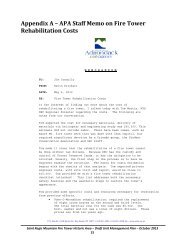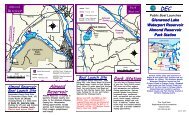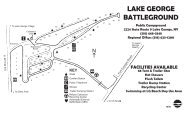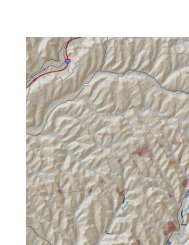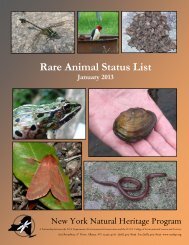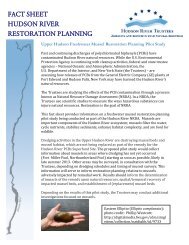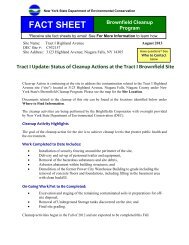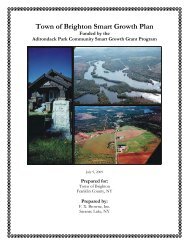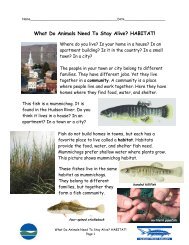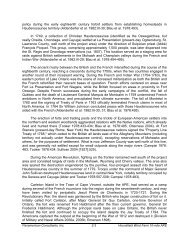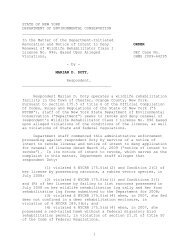Appendix K-7 (PDF) - New York State Department of Environmental ...
Appendix K-7 (PDF) - New York State Department of Environmental ...
Appendix K-7 (PDF) - New York State Department of Environmental ...
You also want an ePaper? Increase the reach of your titles
YUMPU automatically turns print PDFs into web optimized ePapers that Google loves.
Photograph 4.104. East elevation <strong>of</strong> Town Hall, Association Island (Panamerican<br />
2008).<br />
Photograph 4.105. North and west elevations <strong>of</strong> Town Hall (Panamerican 2008).<br />
Panamerican Consultants, Inc. 4-97 Hounsfield Wind Farm 10-mile APE
Photograph 4.106. Intact section <strong>of</strong> allee <strong>of</strong> deciduous trees along Association<br />
Lane, south <strong>of</strong> Ontario Lodge, Association Island (Panamerican 2008).<br />
Photograph 4.107. East façade <strong>of</strong> Ontario Lodge & Towers (Panamerican 2008).<br />
Panamerican Consultants, Inc. 4-98 Hounsfield Wind Farm 10-mile APE
Photograph 4.108. East façade <strong>of</strong> Ontario Lodge & Towers (Panamerican 2008).<br />
Photograph 4.109. East façade <strong>of</strong> Ontario Towers (Panamerican 2008).<br />
Panamerican Consultants, Inc. 4-99 Hounsfield Wind Farm 10-mile APE
Photograph 4.110. West façade <strong>of</strong> Ontario Lodge & Towers, Association Island<br />
(Panamerican 2008).<br />
Photograph 4.111. Association Lane with North Bath House and Olympic Lodge<br />
& Towers (Panamerican 2008).<br />
Panamerican Consultants, Inc. 4-100 Hounsfield Wind Farm 10-mile APE
Photograph 4.112. East and north elevations <strong>of</strong> North Bath House (Bath House<br />
No. 2) (Panamerican 2008).<br />
Photograph 4.113. South and east elevations <strong>of</strong> North Bath House (Panamerican<br />
2008).<br />
Panamerican Consultants, Inc. 4-101 Hounsfield Wind Farm 10-mile APE
Photograph 4.114. Clubhouse (modified former Hospital building), south<br />
elevation (see Figure 4.32), Association Island (Panamerican 2008)<br />
Photograph 4.115. Clubhouse (modified former Hospital building), south<br />
elevation, with allee <strong>of</strong> trees intact at left, Association Island (Panamerican 2008).<br />
Panamerican Consultants, Inc. 4-102 Hounsfield Wind Farm 10-mile APE
Photograph 4.116. Modified former Hospital building, northern wing at right (see<br />
Figure 4.32), Association Island (Panamerican 2008).<br />
Photograph 4.117. Olympic Marina on east side <strong>of</strong> Association Island, Henderson<br />
Harbor, facing northeast (Panamerican 2008).<br />
Panamerican Consultants, Inc. 4-103 Hounsfield Wind Farm 10-mile APE
Photograph 4.118. Skeet shoot high house at north end <strong>of</strong> Association Island<br />
(Panamerican 2008).<br />
Photograph 4.119. “Sunset Cottages” at Association Island (Panamerican 2008).<br />
Panamerican Consultants, Inc. 4-104 Hounsfield Wind Farm 10-mile APE
Photograph 4.120. Residence and stone foundation on Snowshoe Island<br />
(Panamerican 2008).<br />
Photograph 4.121. Large fieldstone fireplace on Snowshoe Island, once part <strong>of</strong><br />
the Associated Island Camp (Panamerican 2008).<br />
Panamerican Consultants, Inc. 4-105 Hounsfield Wind Farm 10-mile APE
4.4 GRENADIER ISLAND, TOWN OF CAPE VINCENT<br />
Grenadier Island is an approximately 1,290-acre island located near the northeastern end<br />
<strong>of</strong> Lake Ontario at the headwaters <strong>of</strong> the St. Lawrence River, two miles from Mud Bay in Cape<br />
Vincent, <strong>New</strong> <strong>York</strong>. The island is 2.3 miles long and 1.4 miles wide. It has two main roads:<br />
Grenadier Island Road #1, which extends southwesterly from Harbor Basin (at the northeastern<br />
corner <strong>of</strong> the island) and follows the southern shoreline; and Grenadier Island Road #3, which<br />
extends west from Harbor Basin near the northern shoreline <strong>of</strong> the island. A pond is located in<br />
the center <strong>of</strong> the island. Almost the entire island is within the 10-mile APE viewshed except for a<br />
narrow swath <strong>of</strong> its northern shoreline. This section provides an historic overview <strong>of</strong> Grenadier<br />
Island.<br />
4.4.1 Grenadier Island History. French explorers and invaders Champlain, La Salle and<br />
Frontenac, who voyaged up the St. Lawrence River to Lake Ontario, were familiar with<br />
Grenadier Island, as were other navigators and explorers who followed. Known to the French as<br />
the Ile de Toniata, after the Native American community in the region at that time, the island is<br />
referenced in numerous French documents (Stanley 1976). It was also known as the “Ile aux<br />
Chevreuil” after French roe deer (Casler 1906:126). The island more than likely served as a<br />
temporary stopping place for early lake travelers (Emerson 1898). After the American<br />
Revolution in 1783, the Mississaugas sold their rights to the land to the Indian <strong>Department</strong><br />
(Stanley 1976). In 1791, the Grenadier and Fox islands, then included in the township <strong>of</strong> Cape<br />
Vincent, were purchased by Alexander Macomb. Over the years, Grenadier Island became a<br />
haven for smugglers. As early as 1803 Samuel English and Hezekiah Barrett had petitioned the<br />
legislature for a patent for Grenadier Island, but it was then uncertain whether it was within the<br />
jurisdiction <strong>of</strong> <strong>New</strong> <strong>York</strong> <strong>State</strong>, hence the request could not be granted (Emerson 1898).<br />
In 1807, the United <strong>State</strong>s passed the Embargo Act restricting trade across the Canadian<br />
border. During the subsequent embargo period smugglers sought refuge on Grenadier Island.<br />
At the onset <strong>of</strong> War <strong>of</strong> 1812, Grenadier Island was situated along the common thoroughfare<br />
between Cape Vincent and the lower St. Lawrence area (and also between Cape Vincent,<br />
Sackets Harbor and Oswego), which conveyed both settlers to the region as well as others who<br />
left the area because <strong>of</strong> the uncertainties <strong>of</strong> war. By the fall <strong>of</strong> 1813, the island served as the<br />
rendezvous for Major General James Wilkinson's Army prior to his disastrous expedition down<br />
the St. Lawrence to capture Montréal (Emerson 1898). It took Wilkinson two months to<br />
assemble his force (ranging between 8,000 and 10,000 men) on the island due to harsh<br />
weather conditions. His troops encountered severe storms and, by late October, the shores <strong>of</strong><br />
Lake Ontario were reportedly “strewn with stranded scows” (Stanley 1978; Lossing 1869).<br />
Wilkinson's entire fleet <strong>of</strong> boats sought refuge from the severe weather at Basin Harbor, at the<br />
eastern end <strong>of</strong> the island. Formed by the wash <strong>of</strong> gravel and sand, the harbor is landlocked by<br />
the mainland on the north and Fox Island on the east. The harbor “is deep enough for any<br />
vessel that sailed the lake and large enough to hold all <strong>of</strong> them” (Bedford 1998:8-9). The<br />
Bedford family, early settlers <strong>of</strong> the island who operated a tavern from a window <strong>of</strong> their<br />
dwelling, boarded the principal <strong>of</strong>ficers while the troops camped near Basin Harbor (Bedford<br />
1998:9). An unidentified disease is reported to have killed many soldiers on the island, as well<br />
as their host, Cornelius Bedford (Bedford 1998:9). Deceased soldiers were buried bare in the<br />
shallow soils <strong>of</strong> the island (Bedford 1998:9). The troops stayed for almost a year on the island.<br />
An account from the period in the Bedford Journal claimed the Army had “completely<br />
devastated all improvements on the island, killed all the cattle and hogs and poultry and even<br />
horses for fresh meat, destroyed fences and out houses although the <strong>of</strong>ficers forbid [sic] and<br />
ordered them to meddle with anything that did not belong to them” (Bedford 1998:9).<br />
Panamerican Consultants, Inc. 4-106 Hounsfield Wind Farm 10-mile APE
Before the construction <strong>of</strong> the Erie Canal, the island’s Basin Harbor served as a layover<br />
for vessels transporting produce from the west to eastern markets down the St. Lawrence River<br />
to Quebec and then to England (Bedford 1998:9). Rafts carrying square timber and staves for<br />
casks and barrels from the dense forest surrounding the lake also harbored in the basin before<br />
heading eastern markets. In 1819, the line dividing Canada and <strong>New</strong> <strong>York</strong> was established.<br />
Grenadier Island was patented to Hezekiah B. Pierrepont, Joshua Waddington and Thomas L.<br />
Ogden on October 1, 1824. On November 10, 1824 title to the island became vested in<br />
Pierrepont, who sold it (and Cherry Island) to William and Gerardus Post, <strong>of</strong> <strong>New</strong> <strong>York</strong>, on<br />
February 19, 1825 for $7,000. The Posts sold land to settlers, despite the number <strong>of</strong> squatters<br />
who had taken up residence on the island and who were reluctant to vacate their improvements<br />
(Emerson 1898).<br />
The pioneer <strong>of</strong> Grenadier Island is supposed to have been John Mitchell, a squatter, who<br />
built a cabin after the War <strong>of</strong> 1812 (Emerson 1898). At the time the Posts assumed ownership,<br />
there were at least 14 families living on the island. The inhabitants were engaged in lumbering,<br />
limited farming, and fishing. The island changed ownership several times. In 1822, there were<br />
approximately 20 families residing on the island. A log school house was built that year near<br />
Basin Harbor on the island’s main north-south road. In 1823, Grenadier Island was surveyed<br />
and recorded as comprising 1,290 acres. By the mid-nineteenth century the island had a cheese<br />
factory. The fishing industry prospered in northeastern Lake Ontario during the nineteenth<br />
century, as thousands <strong>of</strong> barrels <strong>of</strong> fish were annually taken with seines and nets located <strong>of</strong>f the<br />
shores <strong>of</strong> Grenadier Island. By the last decade <strong>of</strong> end <strong>of</strong> the nineteenth century, the extensive<br />
fisheries had dissolved.<br />
Grenadier Island reportedly served as a station on the Underground Railroad. Central and<br />
Northern <strong>New</strong> <strong>York</strong> were part <strong>of</strong> the Underground Railroad, as the cities <strong>of</strong> Syracuse and<br />
Oswego were the hubs <strong>of</strong> <strong>New</strong> <strong>York</strong>’s freedom trail. Fugitives would travel to Cape Vincent and<br />
other local areas to cross over to Canada. According to Nellie Casler, former historian for the<br />
Town <strong>of</strong> Cape Vincent, the island had a safe house with a hidden room for fugitive slaves<br />
(Casler 1906). The safe house’s location on the island has not been formally investigated. The<br />
Great Lakes Seaway Trail has recognized Grenadier Island’s association with the Underground<br />
Railroad in one <strong>of</strong> its history lessons for the Learning on the Great Lakes Seaway Trail program<br />
(Sullivan nd:3).<br />
During the 1870s the island contained at least a dozen farmsteads “varying in size from 32<br />
to 190 acres.” Each farm reportedly had an orchard. During the 1880s, the island became a<br />
popular summer tourist destination. The farmers on the island supported the tourist industry with<br />
produce, as well as producing milk for Jefferson County’s flourishing cheese industry. A new<br />
one-room frame school with an outhouse was constructed in the late nineteenth century in the<br />
center <strong>of</strong> the island on the main road. This building is not the ca. 1822 schoolhouse <strong>of</strong> log<br />
construction, which stood farther east, closer to Basin Harbor. The school is still extant (Figure<br />
4.41). By 1893, there were seven structures and one main road on the island (Figure 4.40).<br />
Development <strong>of</strong> the Thousand Islands region as a recreational destination at the end <strong>of</strong><br />
the nineteenth century was evidenced at Grenadier Island in 1902 by the construction <strong>of</strong><br />
Halcyon Point at the northeastern tip <strong>of</strong> the island. Edward B. Talcott <strong>of</strong> <strong>New</strong> <strong>York</strong> built an<br />
impressive estate as his summer home (Casler 1906:127). Talcott had visited Cape Vincent and<br />
its vicinity for twenty years before he purchased a nearly mile long tract along <strong>of</strong> waterfront on<br />
Grenadier Island (Casler 1906:127). In addition to his home, he constructed a building for<br />
helpers and guides, cold storage, a boathouse, and a wharf. Mrs. Josephine Weeks and her<br />
husband, Judge Bartow S. Weeks, improved what became the Moro Estate at Halcyon Point for<br />
Panamerican Consultants, Inc. 4-107 Hounsfield Wind Farm 10-mile APE
a reported quarter <strong>of</strong> a million dollars (Thousand Islands Sun 1952). The one time “magnificent”<br />
stone Moro Castle with its “luxurious furnishings” became one <strong>of</strong> the finest estates in Eastern<br />
Lake Ontario (Thousand Islands Sun 1952). In 1952, the 101-acre estate was purchased by the<br />
local firm <strong>of</strong> Wagoner & Holman and was then placed at auction (Watertown Times 1952). Avid<br />
fisherman and duck hunter William L. Clay <strong>of</strong> Rochester, <strong>New</strong> <strong>York</strong>, purchased the estate and<br />
Basin Harbor at auction for $5,500 (Thousand Islands Sun 1952). The contents <strong>of</strong> the house<br />
were also auctioned <strong>of</strong>f.<br />
Figure 4.40. Grenadier Island, Cape Vincent, Jefferson County (USGS 1895<br />
[surveyed 1893] 15’ Quadrangle).<br />
Panamerican Consultants, Inc. 4-108 Hounsfield Wind Farm 10-mile APE
Figure 4.41. Grenadier Island School House, Grenadier Island, Cape Vincent<br />
(Wikipedia 2008).<br />
Grenadier Island Grassland. Grenadier Island Grassland Preserve is an approximately<br />
400-acre nature preserve, which encompasses roughly 31 percent <strong>of</strong> the island (Figures 4.42<br />
and 4.43). It is an important part <strong>of</strong> the nesting bird and raptor habitats <strong>of</strong> this large island<br />
(Thousand Islands Land Trust [TILT] 2008). The preserve has little human disturbance,<br />
extensive grasslands, and abundant food sources for bird habitats.<br />
Panamerican Consultants, Inc. 4-109 Hounsfield Wind Farm 10-mile APE
Figure 4.42. TILT’s Grenadier Island Grassland Preserve (Jefferson County Planning<br />
<strong>Department</strong> 2007).<br />
Panamerican Consultants, Inc. 4-110 Hounsfield Wind Farm 10-mile APE
Figure 4.43. Grenadier Island Grassland, Cape Vincent, Jefferson County (Thousand<br />
Island Land Trust 2007).<br />
4.4.2 Grenadier Island Previous Architectural Investigations. Two historic resources<br />
on Grenadier Island were previously surveyed as part <strong>of</strong> an architectural investigation<br />
conducted for the St. Lawrence Wind Project (TRC 2008). These resources were the<br />
Abandoned Farm (no street number) on Grenadier Island Road #3 (USN 04505.000160; TRC<br />
ID No. H-36) and the Uhlein House at 2533 Grenadier Island Road #1 (USN 04505.00016061;<br />
TRC ID No H-37). The St. Lawrence Wind Project five-mile APE included only the northeastern<br />
half <strong>of</strong> the island.<br />
The Abandoned Farm on Grenadier Island Road #3 (USN 04505.000160; Figure 4.44)<br />
was determined NRE under Criterion A for its association with the development <strong>of</strong> Grenadier<br />
Island and its once prosperous agricultural community (Bonafide 2008). The abandoned farm is<br />
locally identified as the “Humphrey Farm House” or otherwise known as the "Carbide House.”<br />
Located on the northern shore <strong>of</strong> the island, the building is not within the Hounsfield Wind Farm<br />
10-mile APE viewshed. The farm house is a ca. 1870, two-story, frame L-shaped building.<br />
Despite its deteriorated condition, the building appears to be the best surviving example <strong>of</strong> a<br />
frame farmhouse on Grenadier Island (see TRC 2008). Approximately a dozen farmsteads were<br />
located on the island in the late nineteenth century. No extant buildings remain intact that<br />
illustrate the agricultural role <strong>of</strong> the property.<br />
NYSOPRHP determined the Uhlein House at 2533 Grenadier Island Road #1 (USN<br />
04505.00016061) as “Not” NRE due to its extensive alterations that include many large modern<br />
Panamerican Consultants, Inc. 4-111 Hounsfield Wind Farm 10-mile APE
additions to an original 1.5-story house (Bonafide 2008; see TRC 2008). The Uhlein house has<br />
an associated mid-nineteenth century stone outbuilding and a large limestone chimney stack<br />
(date unknown [Figure 4.45]). The original stone block is three-bays wide by one-bay deep with<br />
its façade fronting east.<br />
An incomplete copy <strong>of</strong> a cultural resources investigation for a proposed utility corridor west<br />
<strong>of</strong> the Basin Harbor area on file at Lyme Heritage Center, with no date or author, noted two<br />
stone gravemarkers (Francis W. Sterling [n.d.] and Vincent Bedford[1878]) were found on the<br />
island in the summer <strong>of</strong> 1995 (Lyme Heritage Center). The location <strong>of</strong> the graves was not<br />
identified.<br />
Figure 4.44. The NRE “Abandoned Farm” on Grenadier Island Road #3 (Humphrey Farm<br />
House/Carbide House; USN 04505.000160) (Wikipedia 2008).<br />
Panamerican Consultants, Inc. 4-112 Hounsfield Wind Farm 10-mile APE
Figure 4.45. Uhlein House at 2533 Grenadier Island Road #1 (USN<br />
04505.00016061) (TRC 2008).<br />
4.4.3 Conclusion. As noted, the current architectural investigation was limited to archival<br />
research. A site visit was not conducted on Grenadier Island as part <strong>of</strong> the 10-mile APE study.<br />
Grenadier Island presently contains three extant nineteenth-century buildings, and<br />
approximately eight seasonal cottages along its southern shoreline. Two <strong>of</strong> three nineteenthcentury<br />
buildings on the island were previously surveyed (TRC 2008; see above section). The<br />
NRE abandoned “Humphrey Farm House,” also known as the "Carbide House," is a two-story<br />
building with a basement and an attic (see Figure 4.44). The other building is the “Stone House”<br />
located in the northeast corner <strong>of</strong> the Island at Harbor Basin, which is part <strong>of</strong> a large seasonal<br />
rental cottage. The “Stone House” was determined “Not” NRE due to extensive modifications.<br />
Despite the “Not” NRE status, the property is <strong>of</strong> local interest as one <strong>of</strong> Jefferson County’s<br />
nineteenth-century stone buildings.<br />
“Grenadier Island School House,” the third building, is a late nineteenth-century one-room<br />
frame school house (see Figure 4.41). It was identified in the 10-mile APE architectural<br />
investigation. The school house is located on Grenadier Island Road in the center <strong>of</strong> the island.<br />
It is a one-story, front-gabled rectangular block set on a stone foundation and sheathed with<br />
clapboard. The fenestration is intact, but the original sash has been replaced. It has a rear ridge<br />
brick chimney. Based on this initial background review, it appears “Grenadier Island School<br />
House” is potentially NRE for its historical association with the development <strong>of</strong> Grenadier Island<br />
and the rural school districts <strong>of</strong> Cape Vincent. It is further architecturally significant as a largely<br />
intact example <strong>of</strong> a frame one-room school house in the Northern <strong>New</strong> <strong>York</strong>.<br />
Overall, Grenadier Island is historically significant for its association with the War <strong>of</strong> 1812<br />
as the headquarters and encampment for Major General James Wilkinson's Army (under NRHP<br />
Panamerican Consultants, Inc. 4-113 Hounsfield Wind Farm 10-mile APE
Criteria A, B and D). The island is further significant for its role in the Underground Railroad as a<br />
safe house for fugitive slaves (under NRHP Criteria A and possibly D).<br />
4.4.4 Little Grenadier Island. Little Grenadier Island is a small island located east <strong>of</strong> the<br />
northeastern corner (Harbor Basin) <strong>of</strong> Grenadier Island (Figure 4.46). The entire island is within<br />
the 10-mile APE viewshed. It was purchased in 1897 by General Louis Fitzgerald <strong>of</strong> Garrisonon-the-Hudson,<br />
and three men from <strong>New</strong> <strong>York</strong> City: Richard H. Halstead, Russell Murray and<br />
George C. Andrea (Casler 1906:138). The following year, buildings were constructed by the four<br />
men, which converted the island into a summer retreat, as was the popular trend in the region<br />
during the late nineteenth century (Figure 4.47).<br />
The current architectural investigation was limited to archival research; a site visit was not<br />
conducted on Little Grenadier Island as part <strong>of</strong> the 10-mile APE study. As such, the extent and<br />
integrity <strong>of</strong> historic resources associated with the ca. 1898 summer estate on Little Grenadier<br />
Island is not known. Based on review <strong>of</strong> aerial photography, there appears to be a few<br />
structures and a dock on the island.<br />
Figure 4.46. Aerial view <strong>of</strong> Little Grenadier Island, Cape Vincent, Jefferson County<br />
(NYSGIS Clearinghouse 2009).<br />
Panamerican Consultants, Inc. 4-114 Hounsfield Wind Farm 10-mile APE
Figure 4.47. An early twentieth-century postcard <strong>of</strong> Little Grenadier Island, Cape Vincent,<br />
<strong>New</strong> <strong>York</strong> (G.H. Glenn Publisher, NY).<br />
Panamerican Consultants, Inc. 4-115 Hounsfield Wind Farm 10-mile APE
4.5 FOX ISLAND, TOWN OF CAPE VINCENT<br />
Fox Island is an approximately 263-acre island situated roughly 0.7 mile to the east <strong>of</strong><br />
Grenadier Island near the northeastern end <strong>of</strong> Lake Ontario at the headwaters <strong>of</strong> the St.<br />
Lawrence River and near the isthmus <strong>of</strong> Point Peninsula in Cape Vincent, Jefferson County<br />
(Figure 4.48). It is a long narrow strip <strong>of</strong> land <strong>of</strong> irregular shape with one main road along its<br />
northwestern shore, Fox Island Road #7. A vast marsh area comprises the east side <strong>of</strong> the<br />
island. The entire island is within the 10-mile APE viewshed except for a narrow swath <strong>of</strong> its<br />
northern shoreline. This section provides an historic overview <strong>of</strong> Fox Island.<br />
Figure 4.48. Aerial view <strong>of</strong> Fox Island, Cape Vincent, Jefferson County, facing east (Woltz<br />
2007).<br />
4.5.1 Fox Island History. Fox Island was identified on early maps as “Isle aux Renard<br />
(Fox)” (Casler 1906:137). Both Grenadier and Fox Islands were purchased by Alexander<br />
Macomb in 1791, and were included in the Town <strong>of</strong> Cape Vincent (Casler 1906:126). The island<br />
is historically associated with the War <strong>of</strong> 1812 and Major General James Wilkinson's Army prior<br />
to his disastrous expedition down the St. Lawrence to capture Montréal (Emerson 1898).<br />
Several <strong>of</strong> Wilkinson’s vessels were wrecked or stranded on Fox Island during the mid-October<br />
storm <strong>of</strong> 1813 (Casler 1906:131). At the close <strong>of</strong> the War <strong>of</strong> 1812, Stephen Bedford, the son <strong>of</strong><br />
Cornelius Bedford, and his family moved from Grenadier Island to Fox Island. The family<br />
resided in a log house on the unoccupied island for at least two winter seasons from 1815 to<br />
1816 (Bedford 1998:11). In the spring <strong>of</strong> 1817, the Bedfords returned to Grenadier Island<br />
(Bedford 1998:13). Furman Fish, son <strong>of</strong> Ebenezer and Anna Arnold Fish, is attributed as the<br />
first owner <strong>of</strong> Fox Island in the late 1830s (Merchant 1946). In 1864, there were two structures<br />
on the island associated with F.J. Fish (Beers 1864).<br />
Panamerican Consultants, Inc. 4-116 Hounsfield Wind Farm 10-mile APE
In 1905, a partnership <strong>of</strong> four men consisting <strong>of</strong> Senator Elon R. Brown <strong>of</strong> Watertown,<br />
Senator Horace White <strong>of</strong> Syracuse, Judge Wallace <strong>of</strong> Albany, and Hone E. Sexton <strong>of</strong> <strong>New</strong> <strong>York</strong><br />
City purchased Fox Island. Five years later, Horace White (1865-1943) became the 37th<br />
Governor <strong>of</strong> <strong>New</strong> <strong>York</strong> <strong>State</strong> (1910). The original lodge building consisted <strong>of</strong> a rustic-inspired<br />
cottage with an open full-width porch (Figure 4.49). The interior <strong>of</strong> the lodge featured antique<br />
furnishings mostly designed by the furniture maker Gustav Stickley. In 1906, White persuaded<br />
the state to turn over to him a large duck marsh just <strong>of</strong>fshore <strong>of</strong> the island (The <strong>New</strong> <strong>York</strong> Times<br />
2007b). Fox Island became a favorite seasonal hunting retreat <strong>of</strong> politicians and state leaders.<br />
Senator Brown, a former <strong>State</strong> Senate leader, died on Fox Island in 1922 <strong>of</strong> an apparent heart<br />
attack (The <strong>New</strong> <strong>York</strong> Times 2007b).<br />
Fox Island’s Governor Horace White Lodge estate has had four owners since the 1905<br />
partnership (The <strong>New</strong> <strong>York</strong> Times 2007a). After White’s death in 1943, Mr. Marcellus and<br />
Clellan S. Forsythe purchased the property from the White estate (Thousand Islands Sun 1980).<br />
It was sold in 1980 by Fox Island Realty Company, which was headed by Mr. Marcellus’ son<br />
John, to S.C. Robinson <strong>of</strong> <strong>New</strong> Albany, Indiana, and Richard Mattox for $160,000 (Thousand<br />
Islands Sun 1980). The property included at that time an airstrip, a 12-room main lodge, a<br />
pheasant-rearing house, dog kennels, barns, a farmhouse, a caretaker’s cottage, two large<br />
boathouses, a duck-decoy house, a boat shed and a pumphouse (Thousand Islands Sun 1980).<br />
In the last two decades, the original main block <strong>of</strong> the lodge has been enlarged and<br />
expanded with the addition <strong>of</strong> lower flanking wings (TRC 2008). The estate recently sold in 2007<br />
for $3.78 million (The <strong>New</strong> <strong>York</strong> Times 2007a). A 40-piece collection <strong>of</strong> Gustav Stickley antique<br />
furnishings was also auctioned (The <strong>New</strong> <strong>York</strong> Times 2007b). The current owner plans to retain<br />
the undeveloped character <strong>of</strong> the island (The <strong>New</strong> <strong>York</strong> Times 2007a).<br />
Figure 4.49. The original Governor Horace White Lodge in the early<br />
1900s, Fox Island (Woltz 2007).<br />
Panamerican Consultants, Inc. 4-117 Hounsfield Wind Farm 10-mile APE
4.5.2 Fox Island: Previous Architectural Investigations. Two historic resources on Fox<br />
Island were previously surveyed as part <strong>of</strong> an architectural investigation conducted for the St.<br />
Lawrence Wind Project (TRC 2008). These include: the Governor Horace White Lodge at<br />
2079/2261 Fox Island Road #7 (USN 04505.000162); and a vacant building on Fox Island Road<br />
#7 (USN 04505.000167). NYSOPRHP determined both <strong>of</strong> these buildings as “Not” NRE. The<br />
St. Lawrence Wind Project five-mile APE included almost all <strong>of</strong> Fox Island except for a small<br />
portion <strong>of</strong> its southern extremities.<br />
The White Lodge has been significantly enlarged since the early 1900s and, except for the<br />
chimneys and the foundation, its original features are not discernable (TRC 2008). The building<br />
has undergone modifications that include replacement siding, primary porch enclosure, and<br />
replacement <strong>of</strong> all original doors and windows (TRC 2008). The lodge also has a caretaker’s<br />
cottage.<br />
The other inventoried structure is a ca. 1870 deteriorated two-story, frame, L-shaped<br />
building with gabled ro<strong>of</strong>. The primary west façade has a one-story hipped porch that has<br />
collapsed. Ro<strong>of</strong> and walls have partially collapsed. There are no associated outbuildings.<br />
4.5.3 Conclusions. Fox Island is one <strong>of</strong> the last privately held islands in the Thousand<br />
Islands region. It remains one <strong>of</strong> the Northeast's finest water fowling destinations. The island<br />
features a sprawling renovated lodge (White Lodge) with native stone fireplaces that includes a<br />
guest house, a large front dock, and mainland dock recently constructed with 70-year steel<br />
pilings and pressure-treated staving; newly constructed protected harbor and docks, associated<br />
large steel storage barn; a harbor house; decoy house; and pumphouse (Woltz 2007). It has a<br />
3,000-ft private grass landing strip. The island also has one late nineteenth-century abandoned<br />
building.<br />
Additional research conducted as part <strong>of</strong> the 10-mile APE study, revealed that Fox Island<br />
is <strong>of</strong> historical significance for its association with events <strong>of</strong> the War <strong>of</strong> 1812 and its proximity to<br />
Grenadier Island (a channel between the islands), which served as the headquarters and<br />
encampment for Major General Wilkinson's Army.<br />
The current architectural investigation was limited to archival research; a site visit was not<br />
conducted on Fox Island as part <strong>of</strong> the 10-mile APE study. As such, the extent and integrity <strong>of</strong><br />
historic resources associated with the ca. 1905-1907 Horace White Lodge has not been<br />
assessed. A previous study <strong>of</strong> the White Lodge did not provide full documentation <strong>of</strong> ancillary<br />
structures and other features <strong>of</strong> the property. Despite alterations to the White Lodge, Fox Island<br />
is locally important for its historical association with the early halcyon days <strong>of</strong> the seasonal<br />
resort development <strong>of</strong> the Thousand Islands region <strong>of</strong> St. Lawrence River and Lake Ontario.<br />
White Lodge is also notable for its owners and guests who were prominent politicians <strong>of</strong> <strong>New</strong><br />
<strong>York</strong> <strong>State</strong> from the early twentieth century.<br />
Panamerican Consultants, Inc. 4-118 Hounsfield Wind Farm 10-mile APE
5.0 Architectural Survey Results<br />
This report documents a total <strong>of</strong> 66 properties: seven individual NRL; one NRL historic<br />
district; two individual NRE; 37 recommended individual NRE (inclusive <strong>of</strong> two cemeteries); and<br />
19 unevaluated properties. Farm complexes with numerous farm buildings or features are<br />
considered as one property. As part <strong>of</strong> the final architectural survey, these properties were<br />
examined along with other historic resources in the positive viewshed. The breakdown <strong>of</strong> the<br />
results follows the order <strong>of</strong> the Annotated List <strong>of</strong> Properties in Section 8.0, which catalogs the<br />
findings <strong>of</strong> this architectural survey. Buildings with limited access due to private lake frontage<br />
(i.e., lake elevation not visible) are identified as unevaluated in this report.<br />
5.1 TOWN OF BROWNVILLE (MCD 04504), JEFFERSON COUNTY<br />
One individual property, the Samuel Read House at 20669 South Shore Road (in Pillar<br />
Point) is recommended as NRE in the Town <strong>of</strong> Brownville. No previously recorded NRL or NRE<br />
properties are located in the ten-mile APE study area section <strong>of</strong> Brownville.<br />
5.2 TOWN OF CAPE VINCENT (MCD 04505), JEFFERSON COUNTY<br />
For the Grenadier islands and Fox Island, the current architectural investigation was<br />
limited to archival research. A site visit was not conducted on these three islands as part <strong>of</strong> the<br />
10-mile APE study (see Sections 4.4 and 4.5). Grenadier Island presently contains three extant<br />
nineteenth-century buildings. Two <strong>of</strong> three nineteenth-century buildings were previously<br />
surveyed (TRC 2008). These include the NRE abandoned “Humphrey Farm House” (also<br />
known as the "Carbide House") and the “Stone House” located in the northeast corner <strong>of</strong> the<br />
island at Harbor Basin, which is part <strong>of</strong> a large seasonal rental cottage. The “Stone House” was<br />
determined “Not” NRE due to extensive modifications. Despite the “Not” NRE status, the<br />
property is <strong>of</strong> local interest as one <strong>of</strong> Jefferson County’s nineteenth-century stone buildings.<br />
“Grenadier Island School House,” the third building, is a late nineteenth-century one-room,<br />
frame school house (see Figure 4.41). Identified in the ten-mile APE architectural research<br />
investigation, the school house building is located on Grenadier Island Road in the center <strong>of</strong> the<br />
island. It is a one-story, front-gabled rectangular block set on a stone foundation and sheathed<br />
with clapboard. The fenestration is intact, but the original sash has been replaced. It has a rear<br />
ridge brick chimney. Based on this initial background review, it appears “Grenadier Island<br />
School House” is potentially NRE for its historical association with the development <strong>of</strong> Grenadier<br />
Island and the rural school districts <strong>of</strong> Cape Vincent. It is further architecturally significant as a<br />
largely intact example <strong>of</strong> a frame one-room school house in the Northern <strong>New</strong> <strong>York</strong>.<br />
Overall, Grenadier Island is historically significant for its association with the War <strong>of</strong> 1812<br />
as the headquarters and encampment for Major General James Wilkinson's Army (under NRHP<br />
Criteria A, B and D). The island is further significant for its role in the Underground Railroad as a<br />
safe house for fugitive slaves (under NRHP Criteria A and possibly D).<br />
Little Grenadier Island was purchased in 1897 by General Louis Fitzgerald <strong>of</strong> Garrison-onthe-Hudson<br />
and three men from <strong>New</strong> <strong>York</strong> City—Richard H. Halstead, Russell Murray and<br />
George C. Andrea (Casler 1906:138). The following year, buildings were constructed by the four<br />
men, who converted the island into a summer retreat. The extent and integrity <strong>of</strong> historic<br />
Panamerican Consultants, Inc. 5-1 Hounsfield Wind Farm 10-mile APE
esources associated with the ca. 1898 summer estate on Little Grenadier Island is not known.<br />
Based on review <strong>of</strong> aerial photography, there appears to be a few structures and a dock on the<br />
island.<br />
Fox Island is one <strong>of</strong> the last privately held islands in the Thousand Islands region. It<br />
remains as one <strong>of</strong> the Northeast's finest water fowling destinations. The island features a<br />
sprawling renovated lodge (White Lodge) with native stone fireplaces that includes a guest<br />
house, a large front dock and mainland dock recently constructed with 70-year steel pilings and<br />
pressure-treated staving; newly constructed protected harbor and docks; associated large steel<br />
storage barn; a harbor house; decoy house; and pumphouse (Woltz 2007). It has a 3,000-ft<br />
private grass landing strip. The island also has one late nineteenth-century abandoned building.<br />
Additional research conducted as part <strong>of</strong> the ten-mile APE study revealed that Fox Island<br />
is <strong>of</strong> historical significance for its association with events <strong>of</strong> the War <strong>of</strong> 1812 and its proximity to<br />
Grenadier Island (a channel between the islands), which served as the headquarters and<br />
encampment for Major General Wilkinson's army.<br />
The extent and integrity <strong>of</strong> historic resources on Fox Island associated with the ca. 1905-<br />
1907 Horace White Lodge has not been assessed. A previous study <strong>of</strong> the White Lodge did not<br />
provide full documentation <strong>of</strong> ancillary structures and other landscape features <strong>of</strong> the property.<br />
Despite alterations to the White Lodge, Fox Island is locally important for its historical association<br />
with the early days <strong>of</strong> seasonal resort development <strong>of</strong> the Thousand Islands region <strong>of</strong> the St.<br />
Lawrence River and Lake Ontario. White Lodge is also notable for its owners and guests, who<br />
were prominent politicians <strong>of</strong> <strong>New</strong> <strong>York</strong> <strong>State</strong> from the early twentieth century.<br />
5.3 TOWN OF HENDERSON (MCD 04509), JEFFERSON COUNTY<br />
Seventeen individual properties are recommended as NRE in the ten-mile APE study area<br />
section <strong>of</strong> Henderson (Table 5.1). An additional 18 properties were assigned an “Unevaluated”<br />
NRHP status because <strong>of</strong> lack <strong>of</strong> access (i.e., principal facades front Lake Ontario). One NRE(I)<br />
property, Association Island, is located in the project viewshed in Henderson. There are no NRL<br />
properties in the ten-mile APE study area in Henderson (see Section 4.3 for historic resources<br />
in Henderson).<br />
Table 5.1. Summary <strong>of</strong> properties in the ten-mile APE study area in the Town <strong>of</strong> Henderson.<br />
Property Name Address Locality NRHP Status<br />
Robert G. Wehle <strong>State</strong><br />
Park<br />
On Lake Ontario Stony Point Unevaluated<br />
Association Island Association Island (h) NRE(I)<br />
Stony Point Light<br />
House<br />
3415 Lighthouse Road Stony Point (h) Recommend Eligible<br />
Crandall Property 3535 Lighthouse Road Stony Point (h) Unevaluated<br />
3597 Lighthouse Road Stony Point (h) Unevaluated<br />
3667 Lighthouse Road Stony Point (h) Unevaluated<br />
Margi Lodge 3693 Lighthouse Road Stony Point (h) Unevaluated<br />
Roe Property 3765 Lighthouse Road Stony Point (h) Unevaluated<br />
Howard Property 3779 Lighthouse Road Stony Point (h) Unevaluated<br />
3787 Lighthouse Road Stony Point (h) Unevaluated<br />
Panamerican Consultants, Inc. 5-2 Hounsfield Wind Farm 10-mile APE
Table 5.1 continued.<br />
Property Name Address Locality NRHP Status<br />
3815 Lighthouse Road Stony Point (h) Unevaluated<br />
3833 Lighthouse Road Stony Point (h) Unevaluated<br />
3845 Lighthouse Road Stony Point (h) Unevaluated<br />
3857 Lighthouse Road Stony Point (h) Unevaluated<br />
Former Tyler Inn 13030 Harbor Road/CR 123 Henderson Harbor (v) Recommend Eligible<br />
Greiner Property 13040 Harbor Road/CR 123 Henderson Harbor (v) Recommend Eligible<br />
13068 Harbor Road/CR 123 Henderson Harbor (v) Recommend Eligible<br />
Hillbrook Cottage 13102 Harbor Road/CR 123 Henderson Harbor (v) Recommend Eligible<br />
R.J.W. Morgan House 13370 Harbor Road/CR 123 Henderson Harbor (v) Recommend Eligible<br />
13399 Harbor Road/CR 123 Henderson Harbor (v) Recommend Eligible<br />
13498 Harbor Road/CR 123 Henderson Harbor (v) Recommend Eligible<br />
13547 Harbor Road/CR 123 Henderson Harbor (v) Recommend Eligible<br />
Gill House Inn 13565 Harbor Road/CR 123 Henderson Harbor (v) Recommend Eligible<br />
13608 Harbor Road/CR 123 Henderson Harbor (v) Recommend Eligible<br />
13611 Harbor Road/CR 123 Henderson Harbor (v) Unevaluated<br />
13643 Harbor Road/CR 123 Henderson Harbor (v) Unevaluated<br />
13644 Harbor Road/CR 123 Henderson Harbor (v) Recommend Eligible<br />
13699 Harbor Road/CR 123 Henderson Harbor (v) Unevaluated<br />
Brown Owl Cottage 13723 Harbor Road/CR 123 Henderson Harbor (v) Unevaluated<br />
Bittersweet Lodge 13773 Harbor Road/CR 123 Henderson Harbor (v) Unevaluated<br />
13799Harbor Road/CR 123 Henderson Harbor (v) Unevaluated<br />
13832 Harbor Road/CR 123 Henderson Harbor (v) Recommend Eligible<br />
Innisfaell 13962 Harbor Road/CR 123 Henderson Harbor (v) Recommend Eligible<br />
13689 Harbor View Road Henderson Harbor (v) Recommend Eligible<br />
Cedarhurst 15318 Snowshoe Road Henderson Harbor (v) Recommend Eligible<br />
Cedar Lodge 15321 Snowshoe Road Henderson Harbor (v) Recommend Eligible<br />
5.4 TOWN OF HOUNSFIELD (MCD 04510), JEFFERSON COUNTY<br />
One property, the former U.S. Coast Guard Station on Galloo Island, is recommended as<br />
NRE (see Section 4.1.3). One NRL property, Galloo Island Lighthouse, is located in the project<br />
viewshed in Hounsfield (see subsection below for Sackets Harbor).<br />
For Stony and Calf islands, the current architectural investigation was limited to archival<br />
research; site visits were not conducted on Stony and Calf islands as part <strong>of</strong> the ten-mile APE<br />
study. As such, the extent and integrity <strong>of</strong> historic resources on these two islands has not been<br />
assessed (i.e., unevaluated for NRHP eligibility).<br />
Stony and Calf islands are privately owned by ConocoPhillips Petroleum. The company<br />
still operates Stony Island Lodge as a corporate retreat. The lodge is historically significant for<br />
its association with the summer resort era <strong>of</strong> eastern Lake Ontario and the Thousand Islands. It<br />
is further possibly architecturally significant for its association with prominent central <strong>New</strong> <strong>York</strong><br />
architect Archimedes Russell and as a representative example <strong>of</strong> rustic lodge resort<br />
architecture. However, the architectural integrity <strong>of</strong> Stony Island Lodge is not known. One other<br />
Panamerican Consultants, Inc. 5-3 Hounsfield Wind Farm 10-mile APE
esource <strong>of</strong> note is a reported cemetery on the island containing the graves <strong>of</strong> former Stony<br />
Island inhabitants. The location <strong>of</strong> the cemetery is not known (Quick 2006:177). The old Stony<br />
Island school house is no longer extant; it succumbed to fire in 1990 (JCJ 1990).<br />
5.5 VILLAGE OF SACKETS HARBOR (MCD 04558), TOWN OF HOUNSFIELD,<br />
JEFFERSON COUNTY<br />
Ten individual properties are recommended as NRE in the APE study area in Sackets<br />
Harbor (Table 5.2). An additional 18 properties were assigned an “Unevaluated” NRHP status<br />
because <strong>of</strong> lack <strong>of</strong> access (i.e., principal facades front Lake Ontario).<br />
The NRL Sackets Harbor Village Historic District is a large district containing some 156<br />
properties, which includes most <strong>of</strong> the village proper (note: the district was assigned a single<br />
map point for this study). Three individual NRL properties are located in the project viewshed<br />
(see Table 5.2), inclusive <strong>of</strong> one contributing property to the district, the Elisha Camp House (it<br />
was assigned its own separate map point for this study).<br />
Table 5.2. Summary <strong>of</strong> properties in the ten-mile APE study area in Sackets Harbor.<br />
Property Address Municipality NRHP Status<br />
Boulton Beach Farms Ambrose Street Sackets Harbor (v) Recommend Eligible<br />
402 Ambrose Street Sackets Harbor (v) Recommend Eligible<br />
518 Ambrose Street Sackets Harbor (v) Recommend Eligible<br />
Sackets Harbor<br />
Battlefield<br />
Black River Bay Sackets Harbor (v) NRL<br />
Madison Barracks Black River Bay Sackets Harbor (v) NRL<br />
328 County HWY 75 Sackets Harbor (v) Recommend Eligible<br />
Lakeside Cemetery Dodge Street Sackets Harbor (v) Recommend Eligible<br />
Military Cemetery Dodge Street Sackets Harbor (v) Recommend Eligible<br />
352 Dodge Street Sackets Harbor (v) Recommend Eligible<br />
362 Dodge Street Sackets Harbor (v) Recommend Eligible<br />
323 East Main Street Sackets Harbor (v) Recommend Eligible<br />
Elisha Camp House 310 General Smith Drive Sackets Harbor (v) NRL<br />
Sackets Harbor Village<br />
Historic District<br />
Main Street Sackets Harbor (v) NRL<br />
390 Ontario Street Sackets Harbor (v) Recommend Eligible<br />
5.6 TOWN OF LYME (MCD 04513), JEFFERSON COUNTY<br />
Eight individual properties are recommended as NRE in the in the ten-mile APE study<br />
area in the Town <strong>of</strong> Lyme (Table 5.3). One property was assigned an “Unevaluated” NRHP<br />
status because <strong>of</strong> lack <strong>of</strong> access (i.e., principal facades front Lake Ontario). Three individual<br />
NRL properties in Lyme are located in the project viewshed. The study area only included Point<br />
Peninsula.<br />
Panamerican Consultants, Inc. 5-4 Hounsfield Wind Farm 10-mile APE
Table 5.3. Summary <strong>of</strong> properties in the ten-mile APE study area in the Town <strong>of</strong> Lyme.<br />
Property Address Municipality NRHP Status<br />
Hanson's High<br />
Rocks<br />
4811 Becker Lane Point Peninsula (v) Unevaluated<br />
Getman<br />
Farmhouse<br />
South Shore Road Point Peninsula (v) NRL<br />
Farm South Shore Road Point Peninsula (v) Recommend Eligible<br />
Farm buildings South Shore Road Point Peninsula (v) Recommend Eligible<br />
South Shore Road Point Peninsula (v) Recommend Eligible<br />
Farm complex<br />
19458 South Shore<br />
Road<br />
Point Peninsula (v) Recommend Eligible<br />
19532 South Shore<br />
Road<br />
Point Peninsula (v) Recommend Eligible<br />
21585 South Shore<br />
Road<br />
Point Peninsula (v) Recommend Eligible<br />
25201 South Shore<br />
Road<br />
Point Peninsula (v) Recommend Eligible<br />
25403 South Shore<br />
Road<br />
Point Peninsula (v) Recommend Eligible<br />
Lance Farm South Shore Road Point Peninsula/Chaumont (v) NRL<br />
Angell Farm South Shore Road Point Peninsula/Chaumont (v) NRL<br />
Panamerican Consultants, Inc. 5-5 Hounsfield Wind Farm 10-mile APE
6.0 Impacts<br />
The study area is a ten-mile radius extending from the perimeter edge <strong>of</strong> the proposed<br />
layout <strong>of</strong> the Hounsfield Wind Farm project site. The project is located in Jefferson County. The<br />
towns included within the project’s ten-mile visual APE primarily include portions <strong>of</strong> the Galloo<br />
Islands in Hounsfield, Henderson, Brownsville, Lyme, and Grenadier and Fox islands in Cape<br />
Vincent. The Village <strong>of</strong> Sackets Harbor, which is 13 miles northeast <strong>of</strong> Galloo Island, was<br />
included in the APE at the request <strong>of</strong> NYSHPO. No structures or buildings will be demolished or<br />
physically altered in connection with the construction <strong>of</strong> the project. Access to the surrounding<br />
historical, recreational, and commercial land uses will not be impeded by the project.<br />
The definition <strong>of</strong> visual impacts has historically been conceptually problematic. The <strong>New</strong><br />
<strong>York</strong> <strong>State</strong> <strong>Department</strong> <strong>of</strong> <strong>Environmental</strong> Conservation (NYSDEC) defines Visual Impact as:<br />
…when the mitigating effects <strong>of</strong> perspective do not reduce the visibility <strong>of</strong> an object to<br />
insignificant levels. Beauty plays no role in this concept. A visual impact may also be<br />
considered in the context <strong>of</strong> contrast. For instance, all other things being equal, a blue object<br />
seen against an orange background has greater visual impact than a blue object seen<br />
against the same colored blue background. Again, beauty plays no role in this concept<br />
[NYSDEC 2000:10-11].<br />
The difficulty, however, lies in defining insignificant levels or in determining the levels <strong>of</strong> contrast<br />
that have an effect. Further, at what level <strong>of</strong> contrast does the effect become adverse? In the<br />
overall assessment, the multivariate natures <strong>of</strong> the NRL and NRE properties in the viewshed<br />
can be considered to a limited degree. In many instances, the setting <strong>of</strong> the property contributes<br />
to its eligibility, while in other cases it is less so or not at all important. In this summary, the level<br />
<strong>of</strong> effect (visibility and contrast) is measured on the dataset as a whole—the National Register<br />
listed and eligible (and potentially eligible) properties within the viewshed (Table 6.1 [end]).<br />
One method used by Panamerican and others for illustrating the degree <strong>of</strong> visual impact is<br />
loosely based on categories suggested by the U.S. Forest Service for assessing visual impacts<br />
on landscapes. In this framework, the project viewshed is divided into zones <strong>of</strong> relative visibility<br />
based on geographical distance from the viewer. In order to present these analyses in a<br />
consistent and comparable manner, Panamerican uses the following categories: Foreground (0-<br />
0.5 mile); Middle ground (0.5-3.0 miles); and Background (3.0 miles to horizon). Only two<br />
properties, the lighthouse and Coast Guard Station on the island, are in the visual foreground<br />
while the remaining properties are well in the background relative to the wind farm. While the<br />
Forest Service inspired scheme has been adapted for a number <strong>of</strong> 5-mile radius studies, versus<br />
the 10-mile radius used here, it does lend some perspective when comparing this project to<br />
other built or planned wind farms. While some <strong>of</strong> the affected historic properties are grouped<br />
together within municipalities—specifically in the villages <strong>of</strong> Sackets Harbor and Henderson<br />
Harbor—and along roads or in associated complexes such as farmsteads, on the whole, the<br />
properties are found across the study area. This typifies dispersed rural settlement as well as<br />
the clustered seasonal and permanent cottages that reflect the seasonal development <strong>of</strong> the<br />
region.<br />
There are 66 NRL, NRE and recommended NRE properties within the topographic<br />
viewshed (Figure 6.1). As noted above, virtually all <strong>of</strong> these properties are located well in the<br />
background. One <strong>of</strong> these properties is the NRL Sackets Harbor Historic District that comprises a<br />
total <strong>of</strong> 156 properties on approximately 71 acres. The total number <strong>of</strong> structures/places within this<br />
extended viewshed (the ten-mile ring and Sackets Harbor) is in the hundreds. However, the bulk<br />
Panamerican Consultants, Inc. 6-1 Hounsfield Wind Farm 10-mile APE



